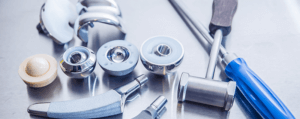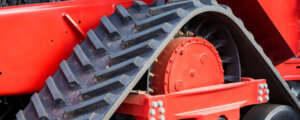Best Practices for Surface Preparation for Bonding
Reading Time: 2 minutes
Last Updated on November 11, 2024
Composite parts and components are tricky because two different materials must successfully bond together and stay that way in challenging applications. Metals, elastomers and plastics have very different physical and performance properties. No matter what materials are used, achieving a good bond depends on choosing the correct adhesive and implementing the best surface preparation techniques.
An adhesive failure is a bond break between the adhesive and the substrate. When a bond fails on a substrate receptive to bonding, it’s usually because of bad surface preparation. This is the case whether you are bonding metals, plastics, etc.
This blog lays out best practices for surface preparation to achieve good adhesion and retain a strong bond.
Degrease Surfaces
Degreasing is important because it removes oils and any loose dirt or other contaminants from the surface of the substrate.
Degrease surfaces using solvents such as acetone or methyl ethyl ketone. You can also use other solvents like isopropyl alcohol depending on the type of substrate involved. Be sure to check all environmental, health and safety regulations before choosing a solvent.
Here are some notes when it is time to degrease the substrate:
- Degreases using vapor, submersion, or wipe w/ an appropriate solvent, degreasing chemical/detergent.
- Perform an additional solvent wipe/rinse if the substrate is then blasted, abraded, or otherwise has its surface treated in a way that might leave behind contaminants.
- Allow degreased parts to flash off/dry before application
Drying with a dirty cloth or towel could lead to recontamination of the surface, so be sure to dry the substrate carefully with a clean cloth after the degreasing process is complete.
Use a Mechanical Abrasion Technique
Mechanical abrasion occurs after degreasing to remove any surface oxidation or heavy contaminants not removed by the degrease. In addition to removing surface films, scale and oxides, mechanical abrasion increases the surface area of the zone intended for bonding.
Effective methods of abrasion include:
- Sand blasting
- Wire brushing
- Roughening with sandpaper
- Steel grit or other media blasting
The technique will largely depend on the type of substrate being used. Some substrates, such as beryllium, can be dangerous to the worker when abraded, so make sure to check all health and safety requirements before starting the process. For metals, an RMS between 150 microinches and 250 microinches is usually recommended.
Relying solely on observation may not be enough to determine whether the substrate has been adequately roughened for bonding. If the substrate is not properly roughened, the bond could fail.
Remember to remove all loose particles from the surface after abrasion by either brushing it, cleaning it or blowing it with compressed air. Once the surfaces have been abraded, they need to be degreased to remove the debris from abrasion. Not doing this properly could cause bond failure.
Use a Surface Treatment
Changing the physical and chemical properties of the surface can sometimes improve adhesion. This is often the case when bonding plastic and metal substrates. You can use a wide range of acids and alkalis for this purpose. The type of chemical will depend on the surface you are treating.
The following surface treatments are sometimes used to improve bonding:
- Phosphitization/Phosphate Treatment (Fe, Ca, and other elemental treatments)
- Corona/Plasma Treatment (especially with difficult to wet/bond plastics
- Acid Etch (Nitric, Chromic, Hydrofluoric, Hydrochloric, etc.)
- Alkaline Etch (Sodium Hydroxide, Potassium Hydroxide, etc.)
Workers should wear appropriate personal protective equipment and need to be well trained in using these treatments. Treatment baths and rinse baths need to be maintained at appropriate temperature and concentration to be certain that surface treatments are consistent from batch to batch.
Once these steps are completed, you are ready for bonding. For more information regarding surface cleaning, please contact an H.M. Royal representative.






